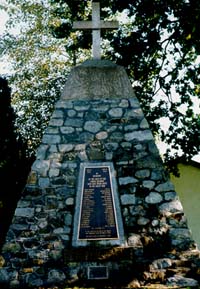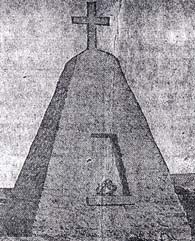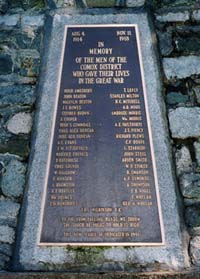
|
|
Sandwick Cairn
|

|

Sandwick, British Columbia
Constructed and unveiled on November 12th, 1922, in memory of those who served and died during World War I. Later, a second plaque was added to the west side of the cairn to honour the World War II dead and, in early 1987, a new plaque to honour the veterans of the Korean War was placed on the cairn.
Vancouver Daily Province reported on June 10th, 1922:
The Governor-General, Lord Byng of Vimy, has been asked to unveil the war memorial cairn at Sandwick when he is on his way to the Yukon this summer.
The war memorial cairn is for the whole district of Comox (excluding Cumberland) and is unique both in conception and construction.

Although to the top of the cross it is eighteen feet high, it will certainly not cost more
than five hundred dollars, about half of which has already been raised. The low cost is
explained by the fact that the labor has been performed voluntarily by the community as a whole. Last November, when the foundation stone was laid, dozens of farmers rose at dawn to load stones taken off their farms to help erect the cairn. Thus, nearly every farm in the valley has contributed to the material of the cairn. While some wagons were hauling rocks, others were at the river loading sand to make the concrete with which the stones are cemented together and the whole of the district turned out to load and unload the wagons and pile up the stones. The design was largely the inspiration of Mr. S.H. Hopkins, district agriculturist, and all who have seen it praise the simplicity and fitness of the memorial to its project. There is nothing ornate, nothing of the workshop about it -- it is a pyramid of stones gathered from the farms which the lads it commemorates knew and loved so well, on the apex of which rises a cross. At the base it is twelve feet square of masonry, reinforced with concrete. The cairn of stones is topped with a solid concrete cap, into which the cross is sunk. A place has been left in front of the monument for the tablet, which will be of marble and upon which there are forty names to be engraved. The tablet will be three feet at the base, two feet at the top and five feet high. While the design has been the work of Mr. Hopkins, the execution of it has been in the hands of Mr. Andy Smith, assisted by working parties of citizens. In addition to the voluntary work which has made the cairn so essentially a community matter, of the hundreds who attended the foundation-stone laying everyone dropped a stone on the cairn, thus contributing his quota to this permanent memorial.
The setting of the memorial is particularly happy. It is built on land given by Mrs. Dingwall, where the Island Highway starts to climb the Sandwick hill by the little white Anglican Church. From its apex the view is of the great glacier of the Beaufort Range which broods over Courtenay, of the peasant pastureland where the greensward is dotted with Jersey herds, of the blue waters of Comox Bay. It is the oldest settled portion of the valley -- the very core and centre of the district which the native Puntledge Indians called the Vale of Plenty.
By the sweat of brow and the labor of hands, for the most part, this memorial has been raised. It is no set design from a stonemason's yard, but the united homage of the whole community to those Comox lads who counted not the cost -- and paid in full. As Rev. Father Beaton pointed out at the foundation-stone laying, the cairn is the symbol of the Celtic race, who marked the abiding place of their dead with a cairn, and the cross that of the Anglo-Saxons, thus representing the two strands out of which the British race has been woven.
Subscriptions are being called for the few hundred dollars needed to complete the monument, and there is no expectation that the task of raising the money will be difficult.

1914 - 1918
|
Hugh Amesbury
John Beaton
Malcolm Beaton
J.E. Bowes
Stephen Brown
E. Cooper
Hugh S. Cummings
Robert George Duncan
Chas. Alex Duncan
A.E. Evans
J.W. Fitzgerald
Maurice Francis
George Gage
J. Gatehouse
Chas. Grundy
W. Halcrow
C. Hansen
L. Harmston
A.T. Hartley
Wm. Holmes
E.G. Humphries
T. Lefly
Stanley Milton
H.C. Mitchell
|
A.B. Mogg
Ambrose Morris
Wm. Morris
A.E. Pailthorpe
J.S. Piercy
Richard Plews
C.F. Roope
L. Storachi
John Steel
Arden Smith
W.D. Stoker
R. Swanson
A.B. Symonds
A. Thompson
F.B. Vogel
E. Whelan
Geo K. Whelan
T.O.L. Wilkinson, V.C.
|
J. Anders
C.T. Armstrong
S. Cameron
W. Campbell
S. Connors
J. Dempsey
T. Garrick
J.M. Gillespie
J. Glover
E.W. Jackson
T. Natsumura
J. Milligan
J. McInulty
J. McIntosh
R. Norman
A. Pickard
A. Slaughter
J. Spears
A. Urquhart
A. Ward
J. Whyte
B. Williamson
W. Wright
M. Yamada
|
1939 - 1945
|
S. Barnes
W.S. Bennett
J. Beston
H. Bischlager
P.W. Bohoslowich
F.P. Browne
J. Bryden
A.M. Carey
R. Carnegie
F. Carter
J. Christie
C.M. Cottingham
H. Cox
J. Devlin
G. Devoy
J.B. Downey
G.H. Ellis
H. Elsey
D. Etherington
J.H. Evans
G. Exel
D. Fairbairn
H. Fleming
A. Galloway
E. Geddes
J. Gossen
C.C. Graham
|
F.C. Griffin
F.V. Hall
J.S.T. Halliday
B. Harvey
K.G. Hatt
A. Hisette
J.B. Hornby
J. Hutchinson
A. Hutton
B.R. Idiens
H.B. Jacobsen
J.R. Lapp
C.L. Leedam
J.D. le Mare
E. Martin
J. Morrison
A. Mortimer
I. Macdonald
I.A. Macdonald
A. McIntyre
I.G.H. McIntyre
N. McPhee
M.A. McQuillan
K.S. Osler
K. Overy
J.D. Owen
D. Peers
R. Perkins
|
A.R. Playfair
J.R. Pollock
W. Porritt
H.W.J. Reading
J.P. Richardson
J.G. Shillito
J. Shortt
H. Slessor
A.E.J. Smith
F. Smith
F.S. Strouts
G. Styles
N.G. Swan
S.G. Tater
F. Taylor
F.C. Thomas
F. Townsley
C. Treherne
H.D. Turnbull
D. Vanstone
J. Vogel
F.L. Waters
J. Williams
A.B. Willson
T.C. Wood
G.S. Wood
M. Yelenich
|

|